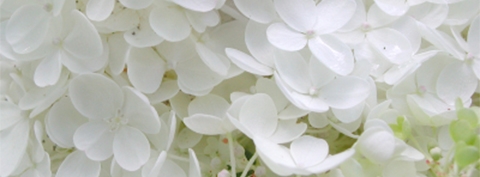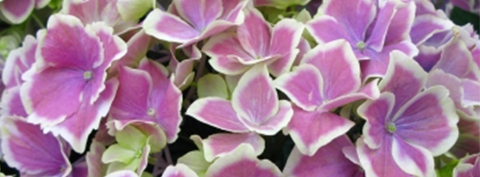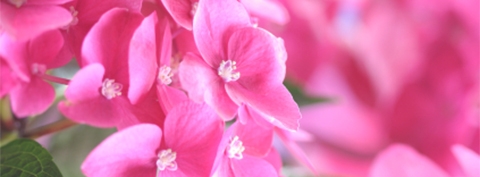There’s nothing shy about hydrangeas! Their enormous pom-poms crowded with star-shaped blooms in shades of pink, blue, lavender, and eggshell epitomize lavish beauty and femininity. Whether you’ve chosen a potted hydrangea as a gift for someone or as a gift to yourself, you’ve chosen wisely.
 Hydrangea combines the Greek words “hydor” meaning water and “angeion” meaning vessel
Hydrangea combines the Greek words “hydor” meaning water and “angeion” meaning vessel
“Everything old is new again” describes this vintage charmer whose enduring appeal is indisputable. England has been enjoying hydrangeas since the 18th century. The French began potting hydrangeas in the early 1900’s, allowing us to enjoy their spectacular flowers indoors as well as out. Today, they’re a favorite among brides and wedding planners for bouquets and table centerpieces. They’ve also become almost synonymous with Mother’s Day, making a memorable gift.
In the language of flowers, hydrangeas symbolize friendship, devotion, perseverance, sincerity, and understanding. Their calming blue shades have also come to mean peace and tranquility. Not surprisingly, these opulent blooms were thought to convey pride and vanity in the conservative Victorian era. Regardless of their meaning, these flowers are sure to start a conversation!
 Hydrangeas originally grew wild in marshes and in N. Asia and the Americas.
Hydrangeas originally grew wild in marshes and in N. Asia and the Americas.
Indoor varieties are specially selected hybrids of Hydrangea macrophylla. In addition to the classic billowy blooms, new varieties have appeared on the scene like lace cap hydrangeas with a delicate ring of large broad florets surrounding a cluster of tight buds, and starburst or shooting star varieties with dense clusters of double florets soaring like exploding fireworks.
Basic Care
Hydrangeas are resilient plants with only a few simple care requirements to be happy & healthy. The varieties you see in garden centers, supermarkets, and florists in the spring have been coaxed into blooming early in warm, bright greenhouses. If you’re bringing them home in cold weather, be sure they are loosely wrapped to protect them from shock. Once home they will flower for up to a month with the right water, light, and temperature.
 When bringing hydrangeas home in cold weather, be sure they're loosely wrapped to protect them
When bringing hydrangeas home in cold weather, be sure they're loosely wrapped to protect them
Water
Hydrangeas are thirsty plants that love moist soil, but hate wet feet. Be sure to not allow the soil to dry out, but resist overwatering as standing water will cause the roots to rot. After bringing your new hydrangea home, give it a good soaking to be sure the soil is moist. Remove the decorative wrap before placing the container in a sink filled with water and let stand for 45 minutes, then drain. Check the soil periodically and water when the feels dry to the touch.
Light
Place your hydrangea in a bright location with indirect sun.
Temperature
Blooms will last longest when temperatures are 50 - 70°F.
Replanting Tips
Once they’ve finished blooming, it’s tempting to try transplanting indoor hydrangeas to the garden. After all, who wouldn’t want to prolong the enjoyment year after year? Hydrangeas are undeniably a great addition to any garden, pairing perfectly with heirloom flowers like monkshood, daylilies, delphinium, lupine, and weigela to create a cottage garden that will be the envy of the neighborhood.
Although transplanting indoor hydrangeas is certainly worth a try, they may not perform as well outdoors as the larger landscape varieties. While botanically the same as garden hydrangeas, many indoor varieties have been cultivated for decorative display rather than winter hardiness. You may want to consider enjoying them as a seasonal accent and discarding them once the blooms are spent.
If you want to try your hand at transplanting indoor hydrangeas, be patient before moving them outside, waiting until the danger of frost has passed and temperatures warm above 50 degrees. Find a spot with at least 3 hours of direct sun in the morning sun and afternoon shade. Blooms that are shielded from the hot midday sun will last longer. If the winters are very cold, also look for an area sheltered from the wind.
 Hydrangeas are thirsty plants that love moist soil, but hate wet feet
Hydrangeas are thirsty plants that love moist soil, but hate wet feet
When conditions are right, set your hydrangea outdoors during the day in a spot with filtered sunlight and bring it back indoors at night. Over the course of a week or so, gradually increase the amount of sun and wind exposure, and your hydrangea will be ready for planting. When you’re ready to plant, simply follows these steps:
- 1. Dig a hole twice as wide and just as deep as the root ball.
- 2. Gently remove the pot and loosen the roots, especially if the plant is pot-bound and very little of the soil is visible.
- 3. Place the plant in the hole and fill in with ½ of the soil and water gently. After the water drains, fill in the rest of the way, using the surplus soil to create a low mound in a ring around the edge of the hole. This ‘moat’ will help guide the water to your new plant’s roots as it establishes.
- 4. Mulch well around the plants to help keep the soil consistently moist and weed-free.
 Hydrangeas develop flower buds almost a year in advance
Hydrangeas develop flower buds almost a year in advance
Troubleshooting
If your hydrangea appears to be drooping, don’t assume it is too dry, it may be just the opposite - too wet! Always check the soil moisture before watering.
If you notice the flowers or leaves starting to shrivel, the sun may be too strong and you’ll need to relocate your hydrangea to spot with less direct sun.








